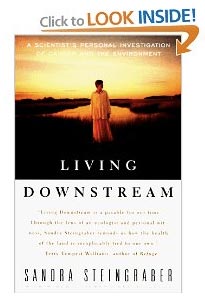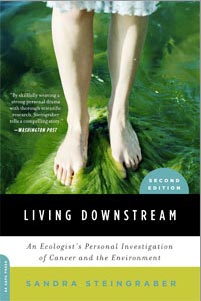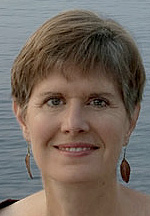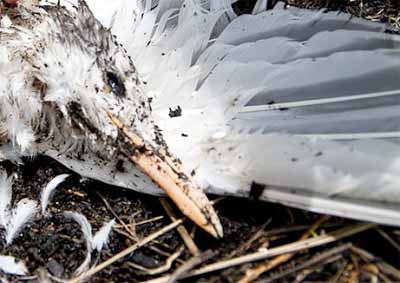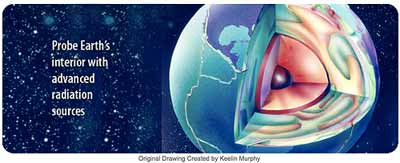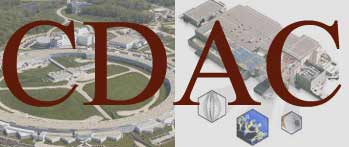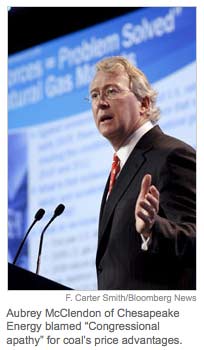Contains the keyword experts
Directed primarily at pregnant and nursing women and babies, Living Downstream discusses the effects that pollution and toxins have on us through our interconnected food chain.
Sandra Steingraber is an internationally recognized expert on the environmental links to cancer and reproductive health. She lives in Ithaca, New York. Read More
A Bridge to Somewhere - Responding to the President's Cancer Panel Report (Part 3) - July 8, 2010
Over the past nine weeks, the President’s Cancer Panel report has been provoking passionate responses from across the country. In a recent editorial, the Los Angeles Times praised the report for broadening the discussion of cancer to include environmental carcinogens and for pointing out how woefully inadequate is our system of regulating them. Likewise, the National Council of Churches applauded the panel for its focus on children, who are more vulnerable to the harmful effects of chemical pollution and in whom cancer rates are rising.
By contrast, an editorial in Chemical & Engineering News condemned the report as alarmist, and the American Cancer Society called it “unbalanced.”
It’s easy to guess what the editor-in-chief of the American Chemical Society’s weekly magazine might find objectionable—perhaps the report’s conclusion entitled “Safer Alternatives to Many Currently Used Chemicals Are Urgently Needed.” But an attack by the nation’s leading cancer charity against a report that argues for cancer prevention via stronger environmental reform deserves a closer look. Especially since one of the report’s authors, oncologist LaSalle Leffall, is a former national president of the American Cancer Society. (And it was George W. Bush who appointed both Leffall and his coauthor, immunologist Margaret Kripke, to their posts—hardly preconditions for a radical takeover.)
See: Living Downstream: The Film (2010)
Directed by Chanda Chevannes
See: Sandra Steingraber. "Shale Game". Orion Magazine. May/June 2010.
See: Sandra Steingraber. "The Whole Fracking Enchilada". Orion Magazine. Sept/Oct 2010.
LEAN was founded to help Louisiana citizens change the balance of power and challenge the continued economic and ecological destruction that had become institutionalized in Lousiana.
By empowering more than one hundred grassroots, community organizations, and countless individuals, LEAN has already helped in gaining a tremendous foothold in the war to make Louisiana's communities safer, healthier places to live. LEAN's expanded efforts will allow the progress already made to continue.
The Natural Resources Defense Council (NRDC) has 1.3 million members and access to the expertise of more than 350 lawyers, scientists and other professionals.
See: Endocrine Disruptors
What is an endocrine disruptor?
An endocrine disruptor is a synthetic chemical that when absorbed into the body either mimics or blocks hormones and disrupts the body's normal functions. This disruption can happen through altering normal hormone levels, halting or stimulating the production of hormones, or changing the way hormones travel through the body, thus affecting the functions that these hormones control. Chemicals that are known human endocrine disruptors include diethylstilbesterol (the drug DES), dioxin, PCBs, DDT, and some other pesticides. Many chemicals, particularly pesticides and plasticizers, are suspected endocrine disruptors based on limited animal studies.
Founded: 1970
Mission: To safeguard the Earth: its people, its plants and animals and the natural systems on which all life depends. Read more
-
Status: Not-for-profit, tax-exempt, membership organization
-
Staff: 300+ lawyers, scientists and policy experts
-
Supporters: 1.3 million members and e-activists
-
Offices: New York, Washington, Chicago, Los Angeles, San Francisco and Beijing
Related articles on the health aspects of environmental stressors.
See: TEDX — The Endocrine Disruption Exchange
NYS Water Resources Institute at Cornell
The Mission of the New York State Water Resources Institute (WRI) is to improve the management of water resources in New York State and the nation. As a federally and state mandated institution located at Cornell University, we are uniquely situated to access scientific and technical resources that are relevant to New York State's and the nation's water management needs. We collaborate with regional, state, and national partners to increase awareness of emerging water resources issues and to develop and assess new water management technologies and policies. WRI connects the water research and water management communities.
See Gas Wells: Waste Management of Cuttings, Drilling Fluids, Hydrofrack Water and Produced Water
See MarcellusShaleReport-6-12-08
….Drilling muds that circulate through the well and return to the surface may contain dissolved and suspended contaminants including cadmium, arsenic, and metals such as mercury, copper and lead; hydrocarbons; hydrogen sulfide and natural gas, as well as drilling mud additives, many of which contain potentially harmful chemicals (e.g., chromate, barite).”
The Consortium for Materials Properties Research in Earth Sciences (COMPRES) is a community-based consortium whose goal is to enable Earth Science researchers to conduct the next generation of high-pressure science on world-class equipment and facilities.
COMPRES is charged with the oversight and guidance of important high-pressure laboratories at several national facilities, such as synchrotrons and neutron sources.
COMPRES is supported by the Division of Earth Sciences at the National Science Foundation.
Goncharov, Alexander. “Unanswered Questions in Deep Carbon Research” presented at the 2009 Annual Meeting keynote | Sloan Deep Carbon Cycle Workshop, Carnegie Institution, Geophysical Laboratory | Washington, D.C., May 15, 2008.
A. Kolesnikov, et al., "Methane-derived hydrocarbons produced under upper-mantle conditions". Nature Geosci., 2, 566-570 (2009).
"Our results support the suggestion that hydrocarbons heavier than methane can be produced by abiogenic processes in the upper mantle."
Recent work carried out at Carnegie/DOE Alliance Center (CDAC) suggests that substantial amounts of the hydrocarbon material could exist in the deep Earth and be formed by inorganic (or abiogenic) processes. These hydrocarbons, which include natural gas and petroleum, could migrate from the mantle to the near-surface region and contribute to 'fossil fuel' reserves. Read more about the work of Alexander Goncharov and colleagues from Sweden and Russia here.
A number of chemical reactions have previously been considered as a potential mechanism for hydrocarbon genesis, but they were not verified experimentally under conditions relevant to the Earth’s interior.
See: Sloan - Carnegie Institution for Science. 2008. Deep Carbon Observatory Founders Committee Meets: Needs and Opportunities in Deep Carbon Cycle Research.
To date, consideration of the global carbon cycle has focused primarily on near-surface (i.e., relatively low-pressure and temperature) phenomena, with the tacit assumption that oceans, atmosphere and shallow surface environments represent an essentially closed system with respect to biologically available carbon.
However, recent data and theoretical analyses from a variety of sources suggest that this assumption may be false.
See: Sloan - Carnegie Institution for Science. 2009. Hydrocarbons in Deep Earth?
The oil and gas that fuels our homes and cars started out as living organisms that died, were compressed, and heated under heavy layers of sediments in the Earth’s crust. Scientists have debated for years whether some of these hydrocarbons could also have been created deeper in the Earth and formed without organic matter. Now for the first time, scientists have found that ethane and heavier hydrocarbons can be synthesized under the pressure-temperature conditions of the upper mantle —the layer of Earth under the crust and on top of the core. The research was conducted by scientists at the Carnegie Institution’s Geophysical Laboratory, with colleagues from Russia and Sweden, and is published in the July 26, advanced on-line issue of Nature Geoscience.
Directed Energy Drilling (from MIT)
Mechanical drilling technologies are fully mature. New approaches are needed to make future major advances in increasing access to and reducing costs for underground energy resources...
...There may be other paths to open well stabilization, unimaginable by current mechanical drilling experience that could make possible record penetration into the Earth’s crust with directed energy sources.
The technology that has been developed by DOE and the world wide fusion energy research community to heat plasmas to 300 million degrees Centigrade opens up new possibilities for drilling that should be explored. (Woskov,Cohn 2009)
See: Center for Dark Energy Biosphere Investigations (C-DEBI)
Gold, Thomas. 1998. The Deep Hot Biosphere : The Myth of Fossil Fuels. New York: Springer | Copernicus, November 6.
Woskov, P., and D. Cohn. Millimeter Wave Deep Drilling For Geothermal Energy, Natural Gas and Oil. Annual Report 2009. Plasma Science and Fusion Center: Massachusetts Institute of Technology, September 2009.
Americans overwhelmingly support government protection of the environment and consumers, a series of new polls shows. The findings come as efforts to enforce and expand regulation face increasingly hostile rhetoric from conservatives and industry representatives in Washington.
A new Society for Human Resource Management/National Journal Congressional Connection Poll (National Journal poll) found wide public support for legislation intended to limit climate-altering greenhouse gas emissions and to reform U.S. energy policy.
Sixty-five percent of poll respondents said they would support a bill that would cap greenhouse gas emissions. The same poll, conducted from July 29 to Aug. 1, found that 78 percent favor requiring utilities to produce more energy from renewable sources.
The House passed a climate and energy bill in June 2009. Senators have introduced several climate bills, but prospects for passage in 2010 appear dim.
See: Food and Water Watch
EnergyBulletin.net is a clearinghouse for information regarding the peak in global energy supply. It is published by Post Carbon Institute whose goal is to provide a roadmap for a transition to a resilient, equitable, and sustainable world by arming individuals, communities, businesses, and governments with the information and resources they need to understand and take action.
Shale Gas Shenanigans
...These shale gas producers are an asset play. And this outcome obviously benefits the Wall Street banks who lend them money. Indeed, this is their exit strategy from the unprofitable drilling treadmill they are currently on. If shale gas production can be said to be in a bubble, this is where that bubble lies. And the strategy is working! Rigzone reports on the acquisition frenzy...
Energy Bulletin is maintained by three editors, Simone Osborn, Kristin Sponsler, and Bart Anderson, based respectively in Bristol, UK, and California USA. Adam Grubb (writing as Adam Fenderson) and Liam Cranley of Melbourne, Australia, founded Energy Bulletin in 2004.
On January 14, 2009, Energy Bulletin was adopted as a core program by the Post Carbon Institute. Except for PCI, Energy Bulletin is unaffiliated with any private, government, or institutional body.
Good job Mr. Kunstler!
If you're offended by salty language, he may not be for you, but the tricks of Big Gas should offend you a whole helluva lot more.
The real story of what happened to the family in Texas that Ms. Stahl did not go into nearly enough. Fracking also reduced their land value from $257,330 on the 2010 tax rolls to its current value of $75,340.
--Vincent Alabama Confidential, outspoken Alabama political bloggers.
So, last night [2010-11-14] CBS hauled Aubrey McClendon, CEO of Chesapeake Energy, on board their flagship Sunday infotainment vehicle, 60 Minutes, to blow a mighty wind up America's ass (as they say in professional PR circles). America is lately addicted to lying to itself, and 60 Minutes has become the "go-to" patsy for funneling disinformation into an already hopelessly confused, wishful, delusional, US public.
McClendon told the credulous Leslie Stahl and the huge viewing audience that America "has two Saudi Arabia's of gas." Now, you know immediately that at least half the viewers misconstrued this statement to mean that we have two Saudi Arabia's of gasoline.
Translation: don't worry none about driving anywhere you like, or having to get some tiny little pansy-ass hybrid whatchamacallit car to do it in, and especially don't pay no attention to them "green" sumbitches on the sidelines trying to sell you some kind of peak oil story.... It also prepared the public to support whatever Mr. McClendon's company wants to do, because he says his company will free America from its slavery to OPEC. By the way, CBS never clarified these parts of the story by the end of the show.
Fossil fuels have powered human growth and ingenuity for centuries. Now that we're reaching the end of cheap and abundant oil and coal supplies, we're in for an exciting ride. While there's a real risk that we'll fall off a cliff, there's still time to control our transition to a post-carbon future.
See:Heinberg, Richard, and Daniel Lerch. The Post Carbon Reader: Managing the 21st Century's Sustainability Crises. 1st ed. University of California Press, 2010.
Music clip used in video below: Reed, Lou. Walk On The Wild Side (1972). RCA/BMG Heritage, 2002.
Post Carbon Institute provides individuals, communities, businesses, and governments with the resources needed to understand and respond to the interrelated economic, energy, and environmental crises that define the 21st century. We envision a world of resilient communities and re-localized economies that thrive within ecological bounds.
Climate change, the end of cheap fossil fuels, and our growth-dependent global economy are creating challenges of a scale and complexity never before seen. These unprecedented challenges call for wholly new approaches.
Post Carbon Institute has gathered 29 of the world's leading experts to point the way forward through a systems oriented, interdisciplinary, and collaborative approach. Through strong partnerships with the Transition Initiative movement and other leading innovators, we work to transform lives and communities through a powerful combination of integrated thinking and replicable direct action. These symbiotic relationships among on-the-ground leaders and grassroots organizers provide the opportunity to immediately implement and test generated ideas and strategies.
The Institute has developed a number of programs and initiatives that further its mission. Visit our program page to learn more.
See: Paul Tolme. 2010-05-14. National Wildlife Federation. "The Dirty Truth Behind Clean Natural Gas".
Flavin, C., and S. Kitasei. The Role of Natural Gas in a Low-Carbon Energy Economy. Briefing paper. Natural Gas and Sustainable Energy Initiative. Washington, D.C.: Worldwatch Institute, 2010. (PDF, 617kb)
Read this assessment by Robert W. Howarth, of Cornell University, who writes, "natural gas is far less attractive than other fossil fuels in terms of the consequences for global warming."
See: Natural Gas Drillers Protest Nomination of Fracking Critics for EPA Review Panel
There’s more carbon locked up in the high north’s permafrost than the combined total released into the atmosphere by humans. The big melt going on right now in the Arctic could trigger a train of catastrophic events across the world.
The Arctic’s soil and permafrost hold nearly twice as much carbon as the earth’s atmosphere, dwarfing the amount of carbon emitted to date by burning fossil fuels. Since the industrial revolution our dependence on coal and oil has ratcheted up the atmosphere’s carbon content, from 560 to 760 gigatons. Permafrost holds an estimated 1,400 gigatons of carbon.
In addition to carbon dioxide, the frozen source is releasing methane, a greenhouse gas 25 times more potent, though it stays in the atmosphere for only a decade rather than for millennia. The gas is bubbling up from land and also from a large, previously overlooked source: permafrost submerged beneath the Arctic Ocean. It’s too early to say whether this is a newly observed steady leak, or if it signals the beginning of a flood of methane.
See: Arctic Thaw May Release Greenhouse Gases from Siberian Peat Bogs
Chemicals Used in Natural Gas Operations. Includes videos, photos, background information.
"TEDX (The Endocrine Disruption Exchange, Inc.) is the only organization that focuses primarily on the human health and environmental problems caused by low-dose and/or ambient exposure to chemicals that interfere with development and function, called endocrine disruptors."
See: Democracy Now! video interview with TEDX founder, Dr. Theo Colburn: The Health Effects of Water Contamination from Fracking.





